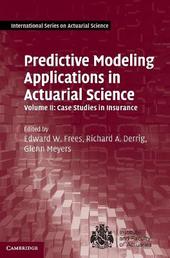
|
Predictive Modeling Applications in Actuarial Science: Volume 2, Case Studies in Insurance
Hardback
Main Details
| Title |
Predictive Modeling Applications in Actuarial Science: Volume 2, Case Studies in Insurance
|
| Authors and Contributors |
Edited by Edward W. Frees
|
|
Edited by Glenn Meyers
|
|
Edited by Richard A. Derrig
|
| Series | International Series on Actuarial Science |
|---|
| Physical Properties |
| Format:Hardback | | Pages:330 | | Dimensions(mm): Height 254,Width 177 |
|
| ISBN/Barcode |
9781107029880
|
| Classifications | Dewey:368.01 |
|---|
| Audience | | Tertiary Education (US: College) | | Professional & Vocational | |
|---|
|
Publishing Details |
| Publisher |
Cambridge University Press
|
| Imprint |
Cambridge University Press
|
| Publication Date |
27 July 2016 |
| Publication Country |
United Kingdom
|
Description
Predictive modeling uses data to forecast future events. It exploits relationships between explanatory variables and the predicted variables from past occurrences to predict future outcomes. Forecasting financial events is a core skill that actuaries routinely apply in insurance and other risk-management applications. Predictive Modeling Applications in Actuarial Science emphasizes life-long learning by developing tools in an insurance context, providing the relevant actuarial applications, and introducing advanced statistical techniques that can be used to gain a competitive advantage in situations with complex data. Volume 2 examines applications of predictive modeling. Where Volume 1 developed the foundations of predictive modeling, Volume 2 explores practical uses for techniques, focusing on property and casualty insurance. Readers are exposed to a variety of techniques in concrete, real-life contexts that demonstrate their value and the overall value of predictive modeling, for seasoned practicing analysts as well as those just starting out.
Author Biography
Edward W. (Jed) Frees is the Hickman-Larson Chair of Actuarial Science at the University of Wisconsin, Madison. He received his PhD in Mathematical Statistics in 1983 from the University of North Carolina, Chapel Hill and is a Fellow of both the Society of Actuaries (SoA) and the American Statistical Association (the only Fellow of both organizations). Regarding his research, Professor Frees has won several awards for the quality of his work, including the Halmstad Prize for best paper published in the actuarial literature (four times). Glenn Meyers, FCAS, MAAA, CERA, and PhD, retired from ISO at the end of 2011 after a 37 year career as an actuary. He holds a BS in Mathematics and Physics from Alma College, Michigan, an MA in Mathematics from Oakland University, Michigan, and a PhD in Mathematics from the State University of New York, Albany. A frequent speaker at Casualty Actuarial Society (CAS) meetings, he has served and continues to serve the CAS and the International Actuarial Association on various research and education committees. He has also served on the CAS Board of Directors. He has several published articles in the Proceedings of the Casualty Actuarial Society, Variance and the Actuarial Review. His research contributions have been recognized by the CAS through his being a three-time winner of the Woodward-Fondiller Prize, a two-time winner of the Dorweiler Prize, the DFA Prize, the Reserves Prize, the Matthew Rodermund Service Award and the Michelbacher Significant Achievement Award. In retirement he still spends some of his time on his continuing passion for actuarial research. Richard A. Derrig is founder and principal of OPAL Consulting LLC., a firm that provides research and regulatory support to property casualty insurance clients. Primary areas of expertise include financial pricing models, database and data mining design, fraud detection planning and implementation, and expert testimony for regulation and litigation purposes.
ReviewsPraise for Volume 1: 'With contributions coming from a wide variety of researchers, professors, and actuaries - including several CAS Fellows - it's clear that this book will be valuable for any actuary whose main concern is using predictive modeling in his or her own work.' David Zornek, Actuarial Review
|